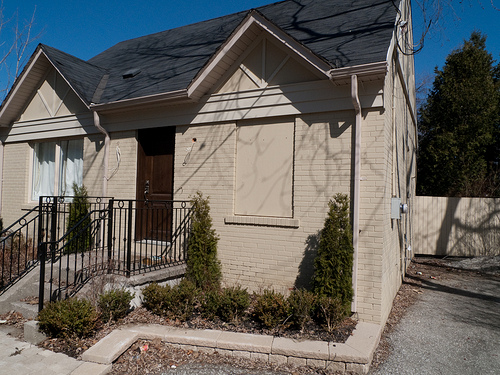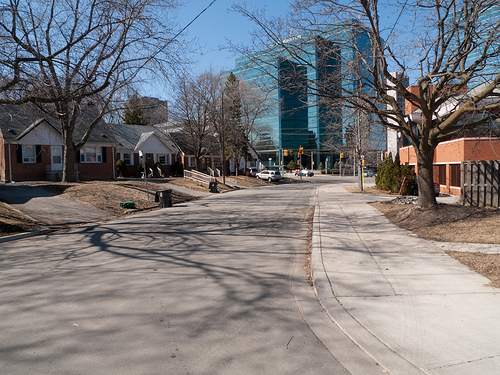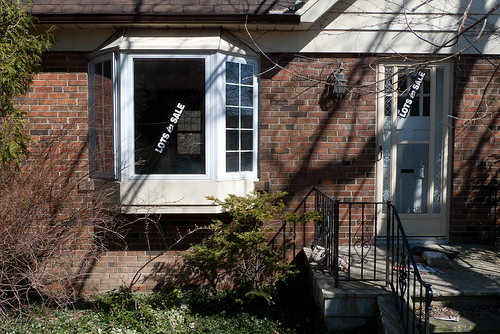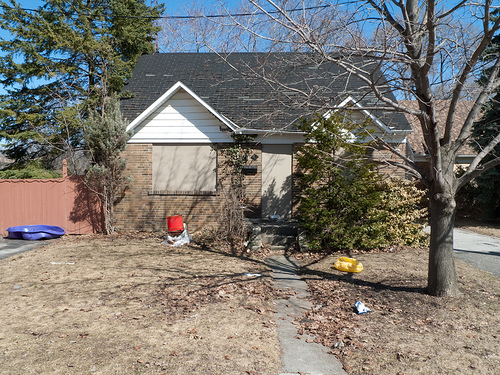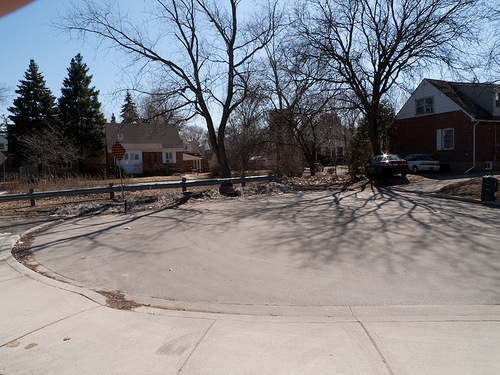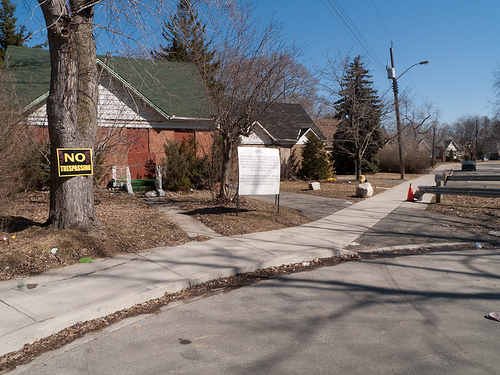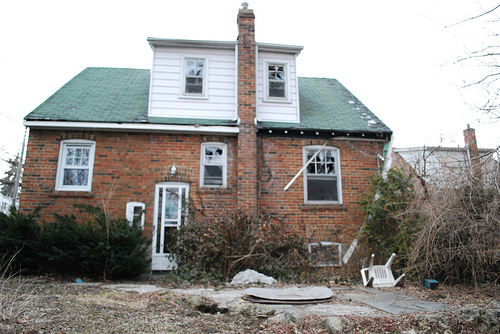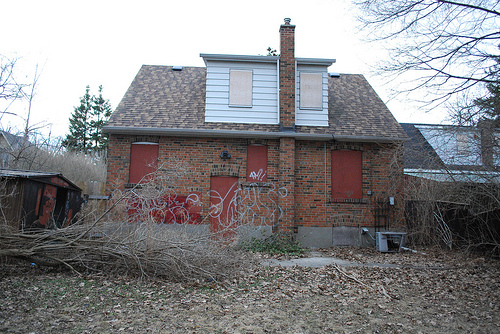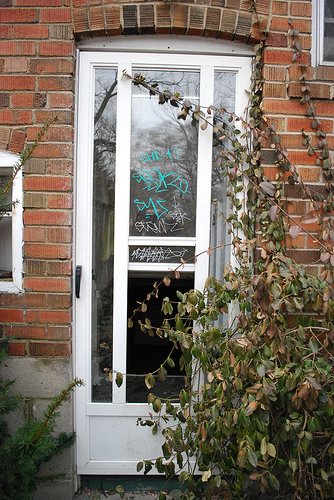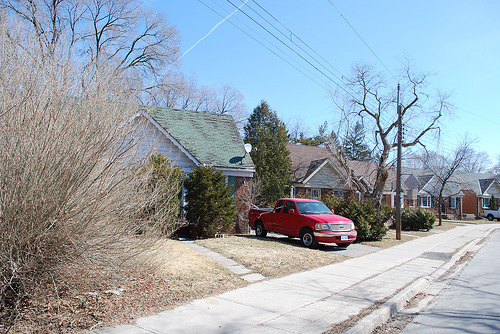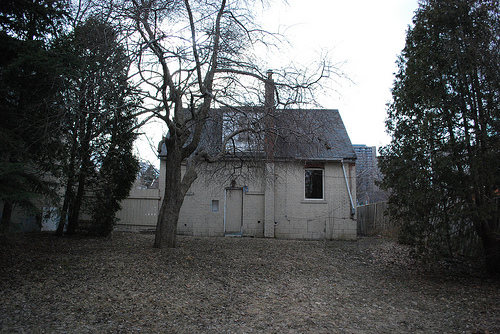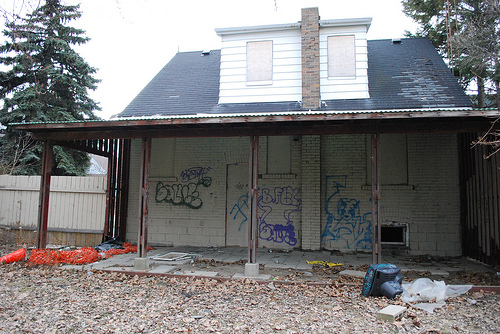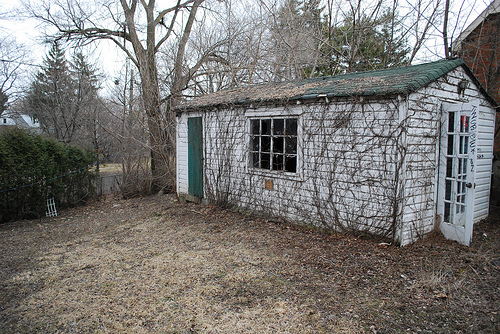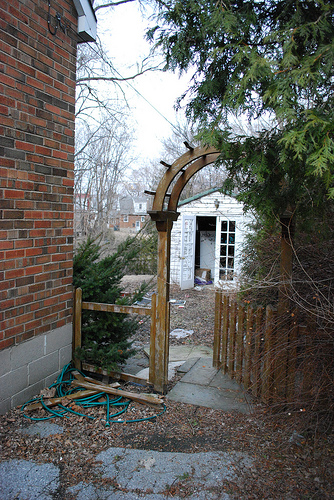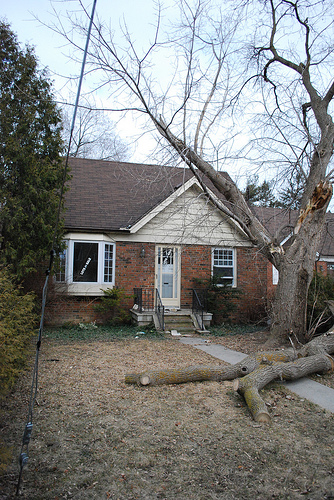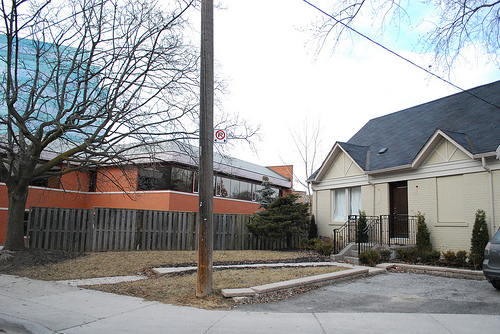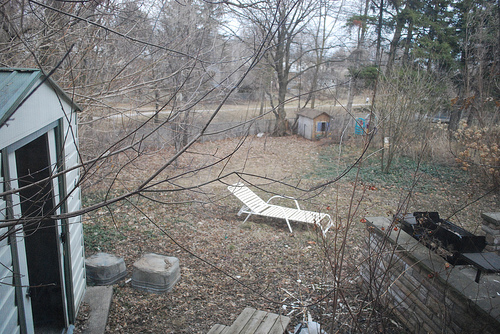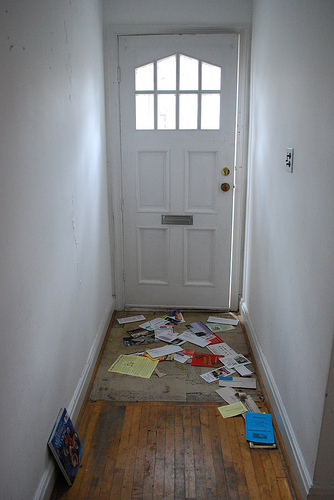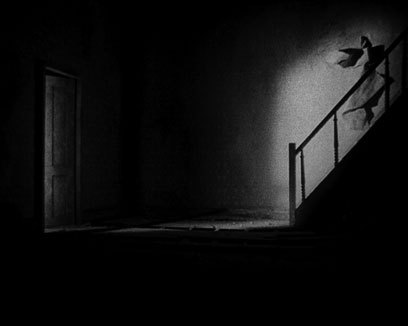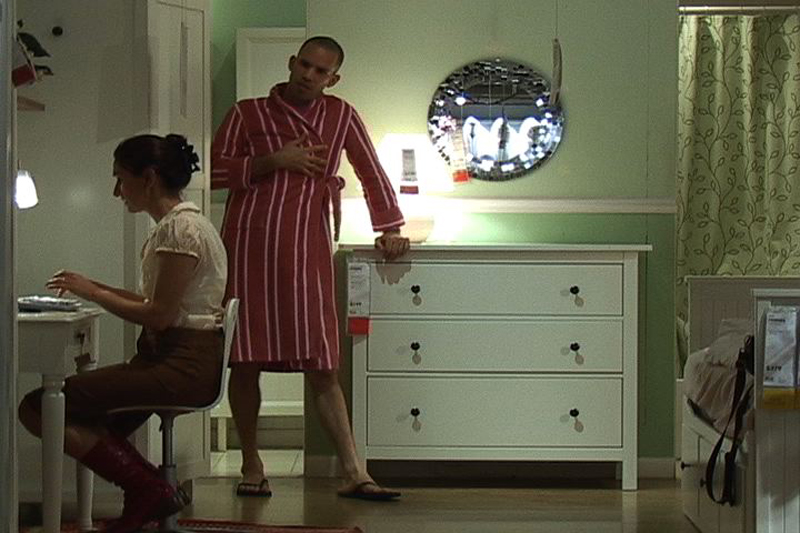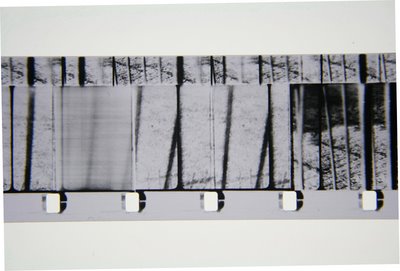Part of Fall 2009
Opening reception 8–11pm. Free shuttle bus from the Toronto International Art Fair and the Gladstone Hotel
Property Is Theft
Co-curated by Jon Davies and Jacob Korczynski
The spaces of suburbia are predicated upon the social contract: the promise between the individual and the collective that sorts what is yours from what is mine. This program of films and videos from around the globe begins with the porous borders that enclose and radiate from the domestic sphere: living room, front door, fence, street, neighbourhood, nation. Dwellings and consumer products become battlegrounds for different ways of inhabiting and imagining the world, as we fight for control over the environments and objects that surround us.
Its title inspired by the popular anarchist maxim originally coined by Pierre-Joseph Proudhon, Property Is Theft. In the Caucasus mountains, a rural family repurposes the fuselage of a crashed military helicopter into a domestic dwelling in Georgian filmmaker Salome Jashi’s short documentary Their Helicopter — an act of détournement that transforms a killing machine into a cozy shelter. The architectural appropriation continues in Israeli artist Guy Ben-Ner’s polemic Stealing Beauty, a Brechtian “sitcom” about family and property starring the artist’s family dressed up and performing inside the domestic showrooms of various IKEAs — all without permission as real shoppers walk by. When the Ben-Ners were kicked out of one simulacral living room or kitchen, they simply continued the scene where they left off at a different IKEA using the magic of continuity editing. American artist Takeshi Murata’s Untitled (Infinite Doors) also features a suite of alluring showrooms, here they are the prizes that lie behind the magic doors on The Price Is Right. Murata transforms the game show into an endless montage of hyperbolic reveals — a factory for desire with no satisfaction in sight. The rhythms of the infinite doors are echoed by the “railings” in British filmmaker Guy Sherwin’s 1977 film of the same name. Part of a series of films that investigates qualities of sound that can be generated directly from the image track, the images of Railings are simultaneously converted into sound, an audio/visual document of the artist’s dérive. Finally, the program will also feature two films by British artist Ben Rivers, linked by their quotidian domestic spaces and an unfolding process of abandonment, decay and renewal: the gently decomposing remnants of what was once a home.
Programme:
Salome Jashi, Their Helicopter (22 min, video, 2006)
Ben Rivers, Old Dark House (4 min, 16mm, 2003) and House (5 min, 16mm, 2005)
Guy Ben-Ner, Stealing Beauty (18 min, video, 2007)
Takeshi Murata, Untitled (Infinite Doors) (2 min, video, 2009)
Guy Sherwin, Railings (10 min, 16mm on its side, 1977)
Bios:
Salome Jashi
After Graduating from Tbilisi State University (Georgia) in 2002 and Caucasus School of Journalism and Media Management in 2003, Salome Jashi worked for Georgian Broadcasting Company Rustavi 2 as a journalist. Along with television production she independently made short video installations. She has completed an MA in Documentary by Practice, department of Media Arts at Royal Holloway, University of London. One of her student films was screened at the National Portrait Gallery as part of the discussion on self-portraiture. She was a member of jury at Norwegian Short Film Festival, 2007. Salome Jashi currently works on several documentary projects. Filmography: Short documentary Their Helicopter (22’10 min). Director / editor. 2006. Short documentary Resistance for Existence (12’20 min). Director / camera operator / editor. 2006. Short documentary self-portrait One of Me (08’04 min). Director / camera operator / editor. 2006.
Ben Rivers
Ben Rivers studied Fine Art at Falmouth School of Art. Since then he has worked predominantly in 16mm film, showing in international festivals, galleries and UK theatres. Recent works have included two commissions from Paul Harnden Shoemakers — making works which fall somewhere between documentary and fiction. These works are then exhibited in mock miniature cinemas in boutiques in Japan, Europe and USA. His latest work is an ongoing series of portraits of people living somehow outside of (the generally accepted idea of) society. The first part — This Is My Land, was premiered at London Film Festival 2006 and exhibited by Measure Arts in London 2007. In 1996, Ben co-founded and has since co-managed/programmed Brighton Cinematheque — renowned for screening a unique programme of film from its earliest days through to the latest artist’s film and video.
Guy Ben-Ner
The video artist Guy Ben-Ner became internationally renowned when he represented Israel at the Venice Biennale in 2005. The work he presented there, Treehouse Kit, deals with a tree made of pieces of furniture, which the artist turns into a tree of survival. It might, thus, serve the modern version of a Robinson Crusoe. Ben-Ner, who completed his art studies in New York in 2003, was the lone survivor already when he showed Berkeley’s Island (1999) — the artist squatting, stranded next to a palm tree on a sandy island, in the middle of his kitchen. The quasi domesticated artist is reluctant to accept the roles allocated today to family members. He does the chores, but discusses his unsatisfied desires, and stresses the incongruity between the cliché-like fury of the artist or the savagery of man, and modern lifestyles. Ben-Ner uses his body in the performance videos in order to paint the self-portrait of the family man. It is also the family man who tries to transmit everyday culture to his son in Wild Boy (2004), or who, in Moby Dick (2000), converts his kitchen into a whaler, which does not hunt legendary animals, as in Herman Melville’s novel, but gets to the bottom of traditional myths.
Takeshi Murata
Takeshi Murata produces extraordinary digital works that refigure the experience of animation. Creating Rorschach-like fields of seething color, form and motion, Murata pushes the boundaries of digitally manipulated psychedelia. With a powerfully sensual force that is expressed in videos, loops, installations, and electronic music, Murata’s synaesthetic experiments in hypnotic perception appear at once seductively organic and totally digital. Takeshi Murata was born in 1974 in Chicago, IL. He graduated from the Rhode Island School of Design in 1997 with a B.F.A. in Film/Video/Animation. Murata has exhibited at The Museum of Modern Art, New York; Museum of Fine Arts, Houston, Texas; Yerba Buena Center for the Arts, San Francisco, California; FACT Centre, Liverpool, UK; Mattress Factory, Pittsburgh, Pennsylvania; New York Underground Film Festival, and the Hirshhorn Museum and Sculpture Garden in Washington, D.C., among others.
Guy Sherwin
Studied painting at Chelsea School of Art in the late 1960s. His subsequent film works often use serial forms and live elements, and engage with light and time as fundamental to cinema. Recent works include performances that use multiple projectors and optical sound, and installations made for an exhibition space. Sherwin taught printing and processing at the London Film-Makers’ Co-op (now LUX) during the mid-70s. His films were included in ‘Film as Film’ Hayward Gallery 1979, ‘Live in Your Head’ Whitechapel Gallery 2000, ‘Shoot Shoot Shoot’ Tate Modern 2002, ‘A Century of Artists’ Film & Video’ Tate Britain 2003/4. He lives in London and teaches at Middlesex University and University of Wolverhampton.
Presented in conjunction with The Leona Drive Project, an exhibition co-curated by Janine Marchessault and Michael Prokopow, a collaboration between the Public Access Collective and L.O.T.: Experiments in Urban Research (www.leonadrive.ca) featuring 18 artist projects installed in five vacant bungalows on Leona Drive in Willowdale from October 23 – 31.
Set in one of Toronto’s oldest inner suburbs, the community of Willowdale in North York, Ontario, The Leona Drive Project is a unique contemporary art exhibition of site-specific installations that address the shifting space of the suburbs. Supplemented with a unique series of public programming initiatives, The Leona Drive Project aims to challenge and expand our understanding of suburban spaces.
The Public Access Collective, in collaboration with L.O.T.: Experiments in Urban Research (Collective), has commissioned eighteen artist projects for a series of five vacant bungalows slated for demolition by HYATT HOMES, a developer in Willowdale (in the Yonge and Sheppard area of Greater Toronto). A group of noted Canadian artists will be working in a variety of media, including audio, architectural installation, projection, photography, sculpture and performance to create new works on display for a period of ten days. The site is easily accessible by subway—only three blocks from the Sheppard station.
The Leona Drive Project artists are: The Arbour Lake Sghool, Thomas Blanchard, Daniel Borins and Jennifer Marman, Robin Collyer, Patricio Davila, Christine Davis, Anna Friz, Richard Fung, Michael Graham, John Greyson, David Han, Oliver Husain, Ryan Livingstone, An Te Liu, Shana MacDonald and Angela Joosse, Michael Taglieri and Kim Tomczak and Lisa Steele. A landscape installation by moimoi and a site-specific project by students from the Claude Watson Arts Program at Earl Haig Secondary School situated only a few blocks away from the site will also be featured. Curators Janine Marchessault (York University) and Michael Prokopow (OCAD) will work collaboratively with the artists and students to develop an exhibition specifically designed to engage with the architecture and spatial design of the houses.
York University Faculty of Fine Arts Professor Janine Marchessault is a Canada Research Chair in Art, Digital Media and Globalization. She is also the Director of the Visible City Project + Archive, which examines artists’ cultures in the context of globalization and a founding member of both Public Access and L.O.T. Michael Prokopow holds a Ph.D. in history from Harvard. Between 2003 and 2007 he served as the curator at the Design Exchange. He is an associate professor in Liberal Studies at OCAD and is a member of the L.O.T. collective.

